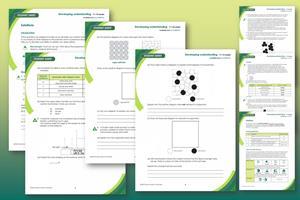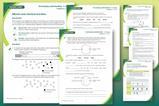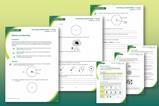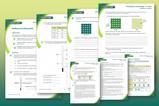Support your learners to develop mental models and deepen understanding of solutions
Developing understanding is a series of resources that encourage learners to connect their thinking at the macroscopic, sub-microscopic and symbolic levels.
-

Download this
A ramped worksheet to help learners develop their mental models of covalent bonding. With icons to indicate the conceptual level/s of each question.
View and download more Developing understanding worksheets
Learning objectives
- Identify a solution from an observation.
- Use particles to explain why mass is conserved when a substance dissolves.
- Explain a suspension in terms of being a mixture of water and small pieces of an insoluble solution.
- Explain a suspension using particle diagrams.
This resource aims to develop learners’ understanding of solutions and dissolving. The questions encourage learners to interpret a range of observations of soluble and insoluble substances being mixed with water and then to think about how these different observations may be represented using particle diagrams. As a result, learners should develop more secure mental models to support their thinking about this topic.
- When to use? Use after initial teaching or discussion of this topic to develop ideas further. You can also use as a revision activity.
- Group size? Suitable for independent work either in class or at home. Or use the questions for group or class discussions.
- How long? 15–30 mins
Johnstone’s triangle
Johnstone’s triangle is a model of the three different conceptual levels in chemistry: macroscopic, symbolic and sub-microscopic. You can use Johnstone’s triangle to build a secure understanding of chemical ideas for your learners.
Introduce learners to Johnstone’s triangle with our Dissolving salt Johnstone’s triangle worksheet which guides learners to explain their observations of mixing sand and salt with water at a macroscopic, sub-microscopic and symbolic level.
Further reading
Read more about how to use Johnstone’s triangle in your teaching with these articles:
- Develop deeper understanding with models
- Improve students’ understanding with Johnstone’s triangle
- Practical ideas for using Johnstone’s triangle
Norman Reid’s book The Johnstone Triangle: The Key to Understanding Chemistry provides a more in-depth overview, the first chapter is available to read online.
Johnstone’s triangle and this resource
The icons in the margin indicate which level of understanding each question is developing to help prompt learners in their thinking.
- Macroscopic: what we can see. Think about the properties that we can observe, measure and record.
- Sub-microscopic: smaller than we can see. Think about the particle or atomic level.
- Symbolic: representations. Think about how we represent chemical ideas including symbols and diagrams.
The levels are interrelated, for example, learners need visual representation of the sub-microscopic in order to develop mental models of the particle or atomic level. Our approach has been to apply icons to questions based on what the learners should be thinking about.
Questions may be marked with two or all three icons, indicating that learners will be thinking at more than one level. However, individual parts of the question may require learners to think about only one or two specific levels at a time.
Support
This worksheet is ramped so that the earlier questions are more accessible. The activity becomes more challenging in the later questions. You can give extra explanations for the more challenging questions. If completing as an in-class activity it is best to pause and check understanding at intervals, as often one question builds on the previous one.
It is useful for learners to observe macroscopic properties first-hand. You could circulate examples of substances in the classroom, run a class practical of a chemical reaction or show a teacher demonstration of properties. Question 1(a) requires learners to know about the solubility of the common kitchen ingredients flour, salt and sugar. A demonstration of these ingredients mixed with water would be beneficial, particularly for learners with little experience of cooking.
Additional support may be needed for any learners still lacking in confidence in the required symbolic representation, for example by sharing and explaining a diagram or a simulation that can show movement of the particles.
Answers and guidance
There are three multi-part questions in the student worksheet. The first question develops learners’ understanding of observations made when soluble and insoluble substances are mixed with water (macroscopic understanding). The second question develops learners’ understanding of how the conservation of measured mass (macroscopic understanding) can be explained in terms of the conservation of the particles (sub-microscopic understanding).
The third question develops learners’ understanding of how a suspension of an insoluble powder is different to a solution of a soluble substance in terms of the arrangement of particles (sub-microscopic understanding). The final part of question three supports learners to understand why a cloudy solution can change to a clear liquid with a layer at the bottom, when the powder settles (macroscopic understanding).
Downloads
Developing understanding of solutions student sheet
Handout | PDF, Size 0.36 mbDeveloping understanding of solutions teacher notes and answers
Handout | PDF, Size 0.31 mbDeveloping understanding of solutions student sheet
Editable handout | Word, Size 0.74 mbDeveloping understanding of solutions teacher notes and answers
Editable handout | Word, Size 0.64 mb


































No comments yet